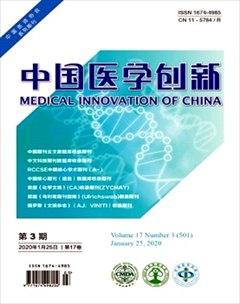连续性护理模式干预对早产极低出生体重儿生长发育的影响
岳秋征 欧阳红梅 周艳君



【摘要】 目的:探究連续性护理模式干预对早产极低出生体重儿生长发育的影响。方法:选取2017年5月-2018年6月本院收治的早产极低出生体重儿60例为研究对象。根据随机数字表法将其分为对照组(常规护理干预)和观察组(连续性护理干预),各30例。比较两组干预前后的头围、身长、体重及24 h呼吸暂停次数,比较两组纠正胎龄后的NBNA评分和CDCC评分,比较两组氧疗时间、住院时间、再次住院率及其他不良情况发生率。结果:干预4、8周后,观察组头围、身长及体重均显著高于对照组,24 h呼吸暂停次数均显著低于对照组,差异均有统计学意义(P<0.05);纠正胎龄后2、4周,观察组NBNA各项评分均显著高于对照组,差异均有统计学意义(P<0.05);纠正胎龄后6、12个月,观察组CDCC各项评分均显著高于对照组,差异均有统计学意义(P<0.05);观察组氧疗时间及住院时间均短于对照组,再次住院率及其他不良情况发生率均低于对照组,差异均有统计学意义(P<0.05)。结论:应用连续性护理模式对早产极低出生体重儿生长发育的影响较好,应用价值较高。
【关键词】 连续性护理模式 早产极低出生体重儿 生长发育
Effect of Continuous Nursing Mode Intervention on Growth and Development of Preterm Very Low Birth Weight Infants/YUE Qiuzheng, OUYANG Hongmei, ZHOU Yanjun. //Medical Innovation of China, 2020, 17(03): 0-088
[Abstract] Objective: To explore the effect of continuous nursing mode intervention on the growth and development of preterm very low birth weight infants. Method: From May 2017 to June 2018, 60 premature infants with very low birth weight in our hospital were selected as the study objects. According to the method of random number table, they were divided into control group (routine nursing intervention) and observation group (continuous nursing intervention), 30 cases in each group. The head circumference, body length, body weight and the number of 24 h apnea were compared before and after the intervention, the NBNA and CDCC scores after correction of gestational age were compared between the two groups, the oxygen therapy time, hospitalization time, the readmission rate and the incidence of other adverse conditions were compared between the two groups. Result: After 4 and
8 weeks of intervention, the head circumference, body length and weight of the observation group were significantly higher than those of the control group, and the number of apnea at 24 hours were significantly lower than those of the control group, the differences were statistically significant (P<0.05). The NBNA scores of observation group were significantly higher than those of control group at 2 and 4 weeks after the correction of gestational age, the differences were statistically significant (P<0.05). After 6 and 12 months of gestational age correction, the scores of CDCC in the observation group were significantly higher than those in the control group, the differences were statistically significant (P<0.05). The time of oxygen therapy and hospitalization in the observation group were shorter than those in the control group, and the rate of readmission and other adverse conditions in the observation group were lower than those in the control group, the differences were statistically significant (P<0.05). Conclusion: The influence of continuous nursing mode for growth and development of premature infant with very low birth weight are better, and has a higher application value.
本研究就应用连续性护理模式对早产极低出生体重儿生长发育的影响进行探究,结果显示,干预4、8周后,观察组头围、身长及体重均显著高于对照组,24 h呼吸暂停次数均显著低于对照组,差异均有统计学意义(P<0.05);纠正胎龄后2、4周,干预组NBNA各项评分均显著高于对照组,差异均有统计学意义(P<0.05);纠正胎龄后6、12个月,观察组CDCC各项评分均显著高于对照组,差异均有统计学意义(P<0.05)。上述结果说明连续性护理模式更为有效地促进了机体与智能的生长发育。同时观察组氧疗时间及住院时间均短于对照组,再次住院率及其他不良情况发生率均低于對照组,差异均有统计学意义(P<0.05)。因此认为连续性护理模式更为有效地促进新生儿全面的生长发育的基础上,有效地控制了不良情况的发生,因此肯定连续性护理模式的应用效果。分析原因,可能与连续性护理模式对新生儿的照顾不仅仅局限于院内有关[13-15],且其干预延续至院外,通过对家长的培训及新生儿的随访干预等多方面的延续性干预[16-18],实现了对新生儿的不间断干预,因此有效保证了新生儿的长时间干预需求[19-22]。
综上所述,本研究认为应用连续性护理模式对早产极低出生体重儿生长发育的影响较好,应用价值较高。
参考文献
[1]苏敏谊,叶秋莲,严素芬,等.出院计划实施小组降低早产极低出生体质量儿再入院率的效果观察[J/OL].实用临床护理学电子杂志,2017,2(19):123-124.
[2]张亚需,傅雅琨,钟水平,等.家庭参与式护理对极低/超低出生体质量儿管理的影响[J].福建医药杂志,2019,40(4):145-146.
[3]李帅,沈俊军,周薇薇,等.非营养性吸吮对持续喂养早产儿生长发育和行为状态的影响[J].安徽医学,2019,40(7):768-770.
[4]赵珂珂.家庭参与式护理管理在NICU内母乳喂养实施中的可行性分析[J].河南医学研究,2019,28(11):2096-2097.
[5] Beebe B,Myers M M,Lee S H,et al.Family Nurture Intervention for Preterm Infants Facilitates Positive Mother-Infant Face-to-Face Engagement at Four Months[J].Dev Psychol,2018,54(11):2016-2031.
[6] Persson M,Shah P S,Rusconi F,et al.Association of Maternal Diabetes with Neonatal Outcomes of Very Preterm and Very Low-birth-weight Infants:An International Cohort Study[J].JAMA Pediatr,2018,172(9):867-875.
[7]罗雁雁.家长参与式护理模式在NICU极低出生体质量儿中的应用效果分析[J].当代医学,2018,24(31):189-190.
[8]林慧宁,刁淑华.延续护理对超/极低出生体重儿出院后早期生长发育的影响[J].全科护理,2019,17(7):878-881.
[9]侯莹,王红宇,邹宁,等.住院极低出生体重儿并发症及预后的临床分析[J].航空航天医学杂志,2018,29(2):165-166.
[10]李斌,许天兰,陈蓉.系统性早期干预对极低出生体重儿神经系统发育的影响[J].贵州医药,2018,42(3):332-333.
[11]封志纯,孔祥永.低出生体重儿的预后及管理[J].中国儿童保健杂志,2018,26(5):465-467.
[12]吕翠媚.发育支持护理对早产极低体重儿体质量和睡眠的影响[J].护理实践与研究,2017,14(1):90-91.
[13]林春苑,古香连,赖颖瑜.袋鼠式护理在早产极低体质量儿中的应用[J].实用临床医学,2017,18(8):90-91.
[14]吕翠媚,曾巧平,邓丽莲,等.精细化管理在极低出生体重儿中的应用[J].护理实践与研究,2017,14(15):72-73.
[15]韩玉珠,李双双,顾堞,等.院外延续性护理在极低出生体重儿中的研究进展[J].当代护士(上旬刊),2019,26(10):9-12.
[16] Sung-Hoon C,Chong-Woo B.Improvement in the Survival Rates of Very Low Birth Weight Infants after the Establishment of the Korean Neonatal Network:Comparison between the 2000s and 2010s[J].J Korean Med Sci,2017,32(8):1228-1234.
[17] Patel A L,Mutlu E A,Sun Y,et al.Longitudinal Survey of Microbiota in Hospitalized Preterm Very Low Birth Weight Infants[J].J Pediatr Gastroenterol Nutr,2016,62(2):292-303.
[18]陈艳辉,应真真.发育支持护理在极低出生体质量儿护理中的应用效果[J].河南医学研究,2019,28(6):1143-1145.
[19]侯文娅,王嘉乐,何淑贞.极低出生体重早产儿的家庭参与式护理[J].护理学杂志,2018,33(7):39-41.
[20]倪志红,盛晓郁,郭宏卿,等.集束化干预在极低出生体重儿发育支持护理中的应用[J].全科护理,2018,16(17):2052-2054.
[21]魏宁,崔岢丰,任晓燕.极低出生体重儿开展新生儿个体化发育支持护理及评估作用分析[J].现代诊断与治疗,2018,29(20):3357-3358.
[22]黄美霞,张美莉.延续性护理对极低出生体重儿智能发育的影响[J].中外医学研究,2016,14(32):65-66.
(收稿日期:2019-11-15) (本文编辑:董悦)

